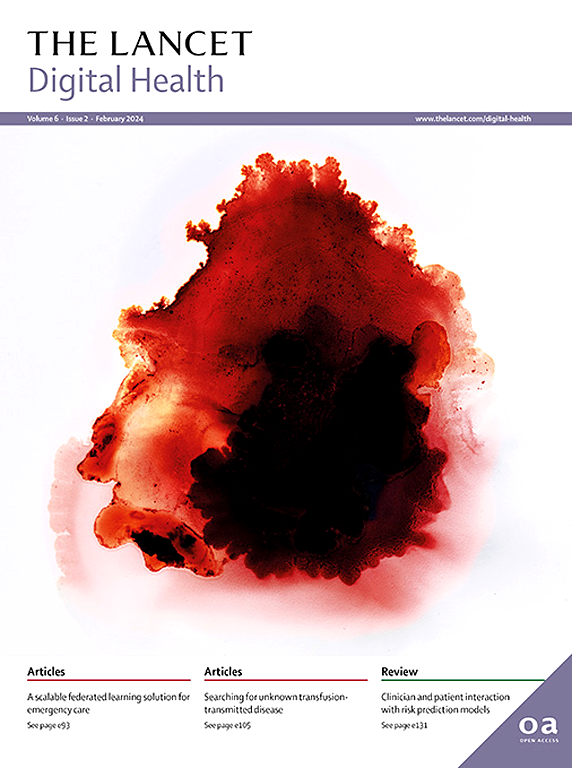Leveraging artificial intelligence for predicting spontaneous closure of perimembranous ventricular septal defect in children: a multicentre, retrospective study in China
IF 23.8
1区 医学
Q1 MEDICAL INFORMATICS
引用次数: 0
Abstract
Background
Perimembranous ventricular septal defect (PMVSD) is a prevalent congenital heart disease, presenting challenges in predicting spontaneous closure, which is crucial for therapeutic decisions. Existing models mainly rely on structured echocardiographic parameters or restricted data. This study introduces an artificial intelligence (AI)-based model, which uses natural language processing (NLP) and machine learning with the aim of improving spontaneous closure predictability in PMVSD.
Methods
We did a multicentre, retrospective analysis using data from 29 142 PMVSD patients across six tertiary centres in China from May, 2004, to September, 2022, for training (70%) and validation (30%; dataset 1, 27 269 patients), and from September, 2001, to December, 2009 for testing (dataset 2, 1873 patients). NLP extracted structured data from echocardiography reports and medical records, which were used to develop machine learning models. Models were evaluated for spontaneous closure occurrence and timing by use of area under the receiver operating characteristic curve (AUC), decision curve analysis, and calibration index.
Findings
Spontaneous closure occurred in 3520 patients (12·1%) at a median of 31 months (IQR 16−56). Eleven NLP-derived predictors, identified via least absolute shrinkage and selection operator, highlighted the importance of defect morphology and patient age. The random survival forest algorithm, selected for its superior concordance indexes, showed excellent predictive performance with validation set AUCs (95% CI) of 0·95 (0·94−0·96) for 1-year and 3-year predictions, and 0·95 (0·95−0·96) for 5-year predictions; testing set AUCs were 0·95 (0·94−0·97) for 1-year predictions, 0·97 (0·96−0·98) for 3-year predictions, and 0·98 (0·97−0·99) for 5-year predictions. The model showed high clinical utility through decision curve analysis, calibration, and risk stratification, maintaining consistent accuracy across centres and subgroups.
Interpretation
This AI-based model for predicting spontaneous closure in PMVSD patients represents a substantial advancement, potentially improving patient management, reducing risks of delayed or inappropriate treatment, and enhancing clinical outcomes.
Funding
National Natural Science Foundation of China, Shanghai Municipal Hospital Clinical Technology Project, Shanghai Municipal Health Commission, and Clinical Research Unit of XinHua Hospital.
利用人工智能预测儿童膜周室间隔缺损的自发关闭:中国的一项多中心回顾性研究。
背景:膜周围室间隔缺损(PMVSD)是一种常见的先天性心脏病,在预测自发性关闭方面提出了挑战,这对治疗决策至关重要。现有模型主要依赖于结构化超声心动图参数或受限数据。本研究引入了一种基于人工智能(AI)的模型,该模型使用自然语言处理(NLP)和机器学习,旨在提高PMVSD的自发闭合可预测性。方法:我们对2004年5月至2022年9月来自中国6个三级医疗中心的29142名PMVSD患者的数据进行了多中心回顾性分析,用于培训(70%)和验证(30%);数据集1,27269例患者),并从2001年9月至2009年12月进行测试(数据集2,1873例患者)。NLP从超声心动图报告和医疗记录中提取结构化数据,用于开发机器学习模型。通过使用接收者工作特征曲线下面积(AUC)、决策曲线分析和校准指数来评估模型的自发关闭发生和时间。研究结果:3520例患者(12.1%)在中位31个月(IQR 16-56)内发生自发性闭合。11个nlp衍生的预测因子,通过最小绝对收缩和选择算子确定,突出了缺陷形态和患者年龄的重要性。随机生存森林算法因其优越的一致性指标而被选中,显示出优异的预测性能,1年和3年预测的验证集auc (95% CI)为0.95(0.94 ~ 0.96),5年预测的验证集auc (95% CI)为0.95 (0.95 ~ 0.96);1年预测的测试集auc为0.95(0.94 ~ 0.97),3年预测的测试集auc为0.97(0.96 ~ 0.98),5年预测的测试集auc为0.98(0.97 ~ 0.99)。通过决策曲线分析、校准和风险分层,该模型显示出很高的临床实用性,在各中心和亚组之间保持一致的准确性。解释:这种基于人工智能的预测PMVSD患者自发闭合的模型代表了一项重大进步,可能改善患者管理,降低延迟或不适当治疗的风险,并提高临床结果。资助项目:国家自然科学基金、上海市医院临床技术项目、上海市卫生健康委员会、新华医院临床研究组。
本文章由计算机程序翻译,如有差异,请以英文原文为准。
求助全文
约1分钟内获得全文
求助全文
来源期刊

Lancet Digital Health
Multiple-
CiteScore
41.20
自引率
1.60%
发文量
232
审稿时长
13 weeks
期刊介绍:
The Lancet Digital Health publishes important, innovative, and practice-changing research on any topic connected with digital technology in clinical medicine, public health, and global health.
The journal’s open access content crosses subject boundaries, building bridges between health professionals and researchers.By bringing together the most important advances in this multidisciplinary field,The Lancet Digital Health is the most prominent publishing venue in digital health.
We publish a range of content types including Articles,Review, Comment, and Correspondence, contributing to promoting digital technologies in health practice worldwide.
 求助内容:
求助内容: 应助结果提醒方式:
应助结果提醒方式:


